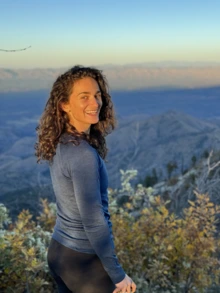Tree-ring data sheds light on past and present summer climate extremes

A new study led by scientists at the University of Arizona used historical tree-ring data to study a key driver for widespread, extreme summer weather events: locked jet stream wave patterns that are often preceded by winter La Niña conditions in the Pacific.
The results from the paper, published in the journal AGU Advances, are poised to inform early warning systems that could better predict extreme weather events that present risks to agricultural crops, food supply, infrastructure and vulnerable populations.

Ellie Broadman
Courtesy of Ellie Broadman
"These types of patterns are particularly impactful, especially when they occur in major crop-growing regions, because they set the stage for what are called 'compound climate events,'" said Ellie Broadman, formerly a postdoctoral researcher of paleoclimatology at the U of A Laboratory of Tree-Ring Research and currently a research scientist at the Arizona Geological Survey. "If you have heat waves and droughts happening in a bunch of different places all in the same summer, that has significant implications for food systems, agriculture, trade and for public health, as compared to one small, isolated drought."
The jet stream is a high-altitude, meandering river of fast-moving air that forms wave-like curves in the atmosphere. When these waves reach a configuration with five peaks and five troughs circling the entire Northern Hemisphere, scientists call it a wavenumber-5 pattern, or wave5 pattern. When the wave5 pattern becomes "locked," or stops moving, it traps heat domes and dry spells over specific regions for days at a time.
Locked wave5 patterns have been linked to extreme weather events happening in multiple regions simultaneously, like the deadly 2003 European heat wave or the triple-continent summer of 2023, when high pressure systems struck the U.S., southern Europe and eastern China.
To determine how often these locked wave patterns occurred before the modern satellite era, Broadman and her team turned to a source not up in our atmosphere, but rooted in the ground: tree rings.
The research team, including collaborators at Columbia University, Northwest University in Xi'an, China, and Universidad Politécnica in Madrid, Spain, used tree-ring data from the past 1,000 years to reconstruct the historical frequency of specific, locked jet stream wave patterns in the Northern Hemisphere that demonstrates a connection between those wave patterns and widespread, summer climate events. It's the first time a reconstruction of the jet stream across the entire Northern Hemisphere has ever been created.
"We don't have direct observational data on the jet stream back more than a few decades, so we're using tree rings as a new way to look at what the jet stream was doing in the past, even without satellite or instrumental records," Broadman said.
Using established drought atlases compiled from tree-ring data, the team identified consistent patterns in three areas known to feel the effects of locked wave5: the Great Plains and Southwest regions of the U.S., and Central Europe. In years with known locked wave5 activity, the trees in these regions showed drought signals, indicated by narrower rings from slower growth.
The researchers then used modern atmospheric data from 1948 to 2018 to develop a statistical model linking these drought patterns to the presence of locked wave5 jet stream behavior. By applying this model to tree-ring records going back 1,000 years, they created the first-ever long-term reconstruction of wave5 activity.
While results did not show an increase in locked wave5 patterns overtime, researchers did discover a clear pattern in what leads to extreme summers. The study shows that La Niña winters, when cool waters dominate the central Pacific Ocean, often precede summers with locked wave5 behavior in the atmosphere.
This finding offers scientists a potentially valuable tool: the ability to inform advanced forecasts of extreme summer weather based on the presence of winter La Niña conditions.
It could also help scientists understand how human-caused global warming is intensifying the dangers posed by naturally occurring jet stream patterns.
"That's why paleoclimate research really matters," Broadman said. "Modern instruments only cover the same period humans have been warming the planet, so you need the long-term view to really understand the impacts of modern climate change."
The concept of using tree-ring data to reconstruct jet stream wavenumber patterns was first proposed by Broadman's postdoctoral supervisor, Valerie Trouet, at the Laboratory of Tree-Ring Research. Trouet laid the foundation for Broadman's analysis, while co-author Kai Kornhuber, a key collaborator at Columbia University, provided the atmospheric circulation patterns that were drawn from reanalysis datasets.
"When studying things like drought, the connection to tree rings is straightforward," Broadman said. “But with something as complex as atmospheric circulation, the relationships are more indirect, so it took more steps and creative thinking to piece it together. This is both a tree ring paper and an atmospheric science paper, and that means experts in two different fields must be confident that your findings are robust."
With global warming continuing to raise the baseline temperature of the planet, even historically normal jet stream patterns can now have more extreme consequences. The locked wave5 configuration might not be appearing more frequently, but its impacts may be growing more severe. What's more, some climate projections suggest that the Pacific Ocean could shift into a more La Niña-like pattern on average, increasing the risk of summers marked by locked wave5 patterns and associated climate extremes, insights that may help inform how communities and decision-makers prepare for the future.





